X (Twitter) Ads Costs: Key Things You Should Know
2024-06-02
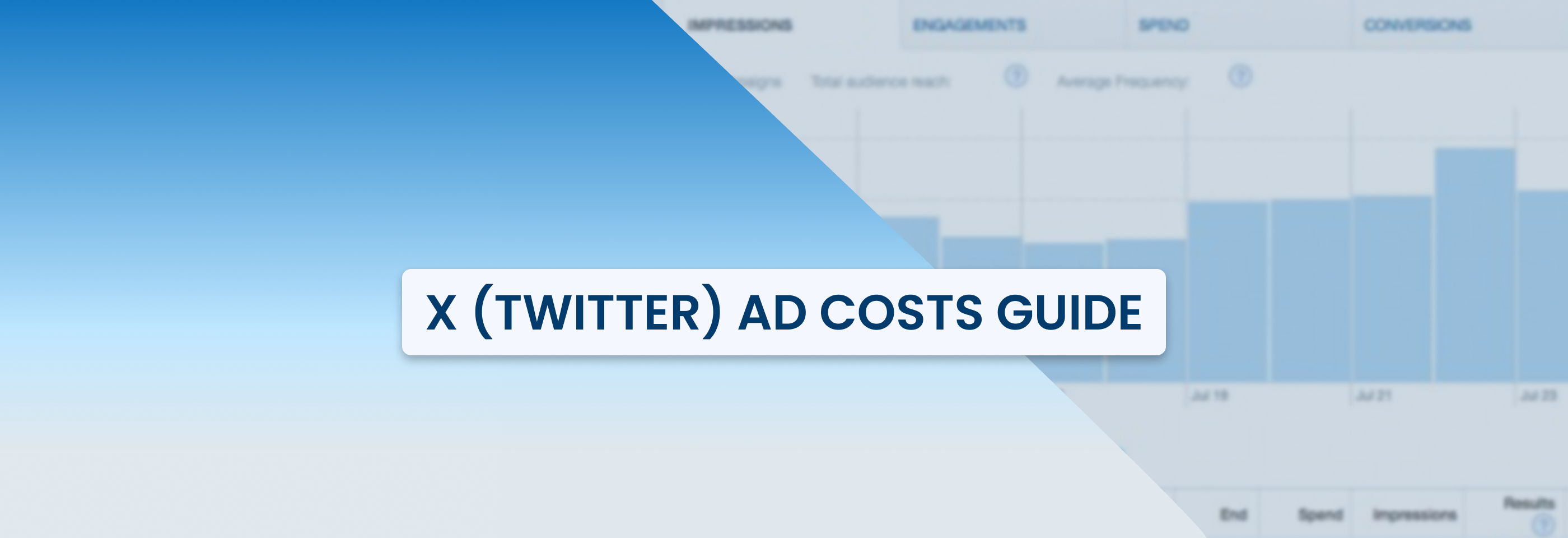
We’ve already discussed why X (Twitter) ads are worth it in our previous article. If you still have your doubts, check it out to learn about the potential benefits X can bring you.
But how much do X Ads cost, and are they actually worth the investment now?
In this article, we’ll try to answer these questions, explore what affects how much X (Twitter) Ads can cost you, and list some helpful strategies to spend your ad budget only on the results you’re looking for.
How much does X advertising cost on average?
On X, advertisers are charged for actions, not impressions. Instead of CPM, there is a CPA that shows how much an advertiser pays for a particular action, like a click, app install, or visiting a website.
According to WebFX’s data, a half of advertisers spend up to $500 on their X ads per month, which makes the platform more or less affordable for marketers with lower-to-medium sized advertising budgets.
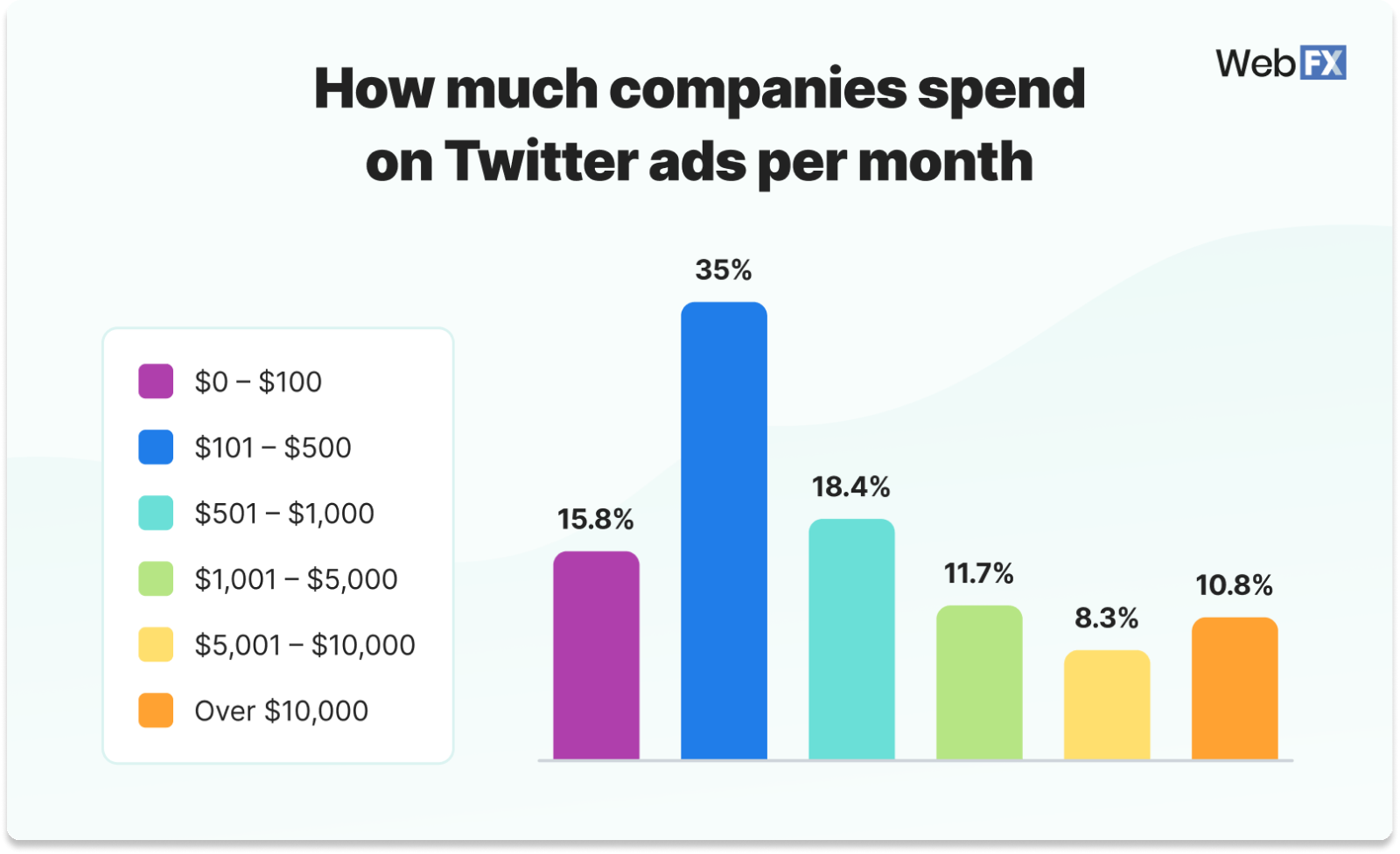
Average monthly ad spend on X (Twitter). Source: WebFX
Cost per first action typically ranges between $0.26 and $1.50 for promoted posts, and cost per follow ranges from less than $1 to $4 for promoted accounts for the majority of advertisers.
Also, there is some good news: you can get a $500 ad credit if you spend $250 on your X ad campaigns, so there’s an additional incentive for advertisers to run their ads on the platform (check the terms to see if you can get this credit too).
Now, let’s dive deeper into the topic to understand what can affect how much you’ll pay for advertising on X.
Key factors that affect the costs of X (Twitter) ads
Each platform has its own rules on how to charge advertisers for their campaigns, and X is no exception. Moreover, besides the platform’s decisions, there are multiple external factors that can influence how much you’ll need to pay for your X ads.
The first thing that we need to understand is that X ads are shown to users through an ad auction where you’ll have to compete with thousands of other advertisers for the spot on X users’ timelines or other placements.
Your ads will automatically enter the auction once your campaign starts based on your targeting criteria. For example, if you target users with specific interests, the auction algorithm will compare your ads to others targeting the same interests, and the winning ad will get shown.
The outcome of the auction will depend on several factors, so let’s start with them.
Billable actions, or what you’re bidding for
The cost of your X ads will depend on the campaign objective and ad group goal you choose. Each of them has a specific action you pay for, and you decide how much to pay for each billable action.
Keep in mind, though, that this amount isn’t fixed since you’re participating in the ad auction, but choosing the right action will help you pay only for the results that you actually need.
For example, if you’re running a traffic campaign, you’ll only pay for clicks that lead people to your website.
Here’s what you can bid for depending on the campaign objective:
- Impressions, i.e. CPM for Reach and Sales campaigns;
- Video views, i.e. Cost per View for Video views campaigns;
- Pre-roll views, i.e. Cost per View for Pre-roll campaigns;
- Impressions or app clicks for App install campaigns;
- Link clicks, i.e. Cost per Click (CPC) for Webite traffic campaigns;
- Engagements, i.e. Cost per Engagement for Engagement campaigns;
- App clicks, i.e. Cost per App Click for App re-engagements campaigns.
Different objectives and goals require different bidding strategies and budgets. You have to align the objectives and goals you choose with your advertising strategy (what do you want to achieve?) and the size of the budget you’re willing to spend.
Bid amount and type
Your bid shows the amount of money you're willing to pay for each billable action based on your campaign objective, and this also affects the ad auction outcomes and the costs of your ads.
When setting up your campaign, X will suggest a bid based on your targeting choices and the size of your audience. This is because your ads will be competing with other advertisers who chose the same audience in the ad auction, and X wants to make sure that you’re setting competitive bids.
If someone who sees your ad performs the action you are billed for (like clicking on your ad), X will charge you based on a second price auction model. This means you’ll have to pay just a bit more than the second-highest bid. For example, you’ll be charged $1.01 for the billable action if the next highest bid is $1.00, even if your bid amount is $1.40.
We’ve already mentioned how much each action on X costs on average, so keep that in mind when setting your bid amount. And remember that the more relevant your ads are to your audience and the higher your bids are, the better your chances of winning the action.
High bids without good ads won’t mean anything, so always match how much you’re willing to bid with the quality of your ads.
Also, there are three types of bids on X Ads that you can pick based on your goals:
1. Automatic bids
This bid type automatically adjusts your bid to get the best results at the lowest price within your budget. It’s great for new advertisers because you don’t have to set your bid yourself. The system chooses it for you to ensure your ad competes well in the auction. Automatic bids are the easiest way to quickly start your campaigns and get them seen on the platform.
2. Maximum bids
With this bid type, you have more control over how much you spend for each action that counts. You decide the most you're willing to pay for an action (your maximum bid), and you won't pay more than that. This bid type is handy for experienced advertisers who know exactly what they want to pay for each important action, especially on a large scale.
When you create or change your campaign, you'll see a suggested bid next to the maximum bid. This happens when you set a campaign budget, a daily budget, and start/end dates. If you adjust your campaign or daily budget, the suggested bid will change too. If you don't set a maximum bid, it will be filled in automatically with the middle value of the suggested bid range.
3. Target bids
This bid type is available for follower, website traffic, reach, app installs, and app re-engagement campaigns. You choose the amount you want to pay for each action that counts, and the system adjusts your bids to meet your target daily spending. You'll pay the average cost for all link clicks in a day. If you change your bid during the day, it will average out to the highest cost you set.
Targeting options and competition
Your targeting choices are another critical factor affecting X advertising costs. There are many ways to target people on X, but each targeting strategy can cost you more or less depending on several things.
For example, while more granular targeting can increase the cost of your ads, it often leads to better engagement and higher conversion rates.
If you’re targeting users based on several interests or behaviors, you can make your ads reach those most likely to be interested in your products or services. But at the same time, you might have to compete with other advertisers for these high-demand audience segments. This means that you’ll need to bid higher to have a chance of winning the ad auction.
The size of your audience also impacts the costs: the larger your audience is, the higher your bids will have to be. But larger audiences can bring better advertising results due to their higher reach and opportunities to discover new profitable audience segments.
As you can see, every targeting option will have its own pros and cons, so you have to find the balance between ad performance and advertising costs to make the right choice.
Ad Score and engagement
To make sure your ads compete well in the ad auction, you need high enough bids. But your bid isn't the only important thing: the quality of your ads matters too.
On X, each ad will get a specific Quality Score. This score and your bid amount will determine the outcome of the auction.
The quality score looks at things like:
- Resonance, i.e. how engaging your ad is for your target audience;
- Relevance, i.e. how closely the content of your ad aligns with your audience’s interests;
- Recency, i.e. how fresh and up-to-date your posts are.
To win the ad auction, your ads need both a high Quality Score and a competitive bid. This is your "ad score", which determines how likely you are to win in the auction.

X (Twitter) calculated Ad Scores based on the quality of your ads and your bids.
Basically, the more engaging, relevant, and fresh your ad is, the less you’ll likely need to spend on it – X will prioritize your ads over the ads of other advertisers if their Quality score is high.
Here’s how all of this can help you run more cost-effective X ads:
- Lower bid prices: ads with high engagement rates and Quality Scores are seen as more valuable by the platform, which can lower the bid amount you’ll need to win the auction;
- Lower Cost-Per-Engagement: higher ad relevancy and engagement can reduce your CPE, making the ad campaign more cost-effective overall if you’re bidding for engagement actions;
- Better ad placements: ads with better scores are more likely to be shown in prime positions where they’ll be the most visible;
- Increased reach: engaging and relevant ads are often shown to a larger audience at lower prices as the platform recognizes their potential to drive interaction;
- Competitive advantage: if your ads are more engaging and relevant than those of your competitors, you might find yourself winning more auctions at lower costs and getting better results from your ads too.
In short, higher Quality Score leads to better results in the ad auction, i.e. better placements and lower costs, which is the ultimate recipe for cost-effective ad campaigns.
Budget
The great thing about X ads is that they can fit your budget no matter how large your business is. There's no minimum amount you have to spend, so you can always decide how much money to allocate to your campaigns.
When setting up campaigns, you have two options:
- Default structure: you can control budgets and flighting at the ad group level, i.e. select both a daily budget and flight dates for each ad group. You can also set a spend cap at the campaign level to limit the total campaign spend;
- Campaign Budget Optimization: if you don’t want to do this manually, you can let X manage your ad budget. You just have to specify a daily budget at the campaign level, and then X will optimize it across all ad groups. You won’t be able to change the budget at the ad group level, though.
X ads usually operate with a daily budget, and the platform’s algorithms won’t go above the limits you set. You can also set a campaign budget to limit the total amount of money you want to spend.
Here’s how each option can impact your advertising costs on X:
- Daily budget at Ad Group level: setting a daily budget helps you control spending and predict daily costs. However, on high competition days, your budget might get exhausted pretty quickly, potentially limiting your reach;
- Spend cap at Campaign Level: spend caps help you ensure that you don't exceed your total budget. This way, you’ll never overspend, but this may limit campaign reach if the cap is too low;
- Campaign Budget Optimization: by allowing X to optimize your budget across ad groups, you can reduce your overall advertising costs as the system will allocate the money where it’s most needed. At the same time, you won’t have the same degree of control over individual ad group budgets, which might result in higher spending for certain ad groups.
Keep this in mind when choosing the right type of budget: if you know the potential drawbacks of each option, you’ll avoid unpleasant surprises when checking how much you’re spending on your X ads.
Flighting
Basically, flighting is like a schedule for your X ads: you can decide when your ads will start running and when they will stop. This can be chosen at the ad group level, and your campaign will start when its first ad group begins and end when its last ad group finishes running.
There are two flighting options you can choose from:
- Start immediately and run continuously: your ad group will run until you reach the budget limit or stop it manually. Since your ad group runs until the budget is reached or manually stopped, it could lead to stable advertising costs but may require regular monitoring to avoid overspending;
- Set start and end dates: your ad group will run only during the specified time range. This can affect your ad costs due to varying demand. For example, running ads during high-demand periods like holidays or special events may increase your costs because more advertisers are competing for ad space.
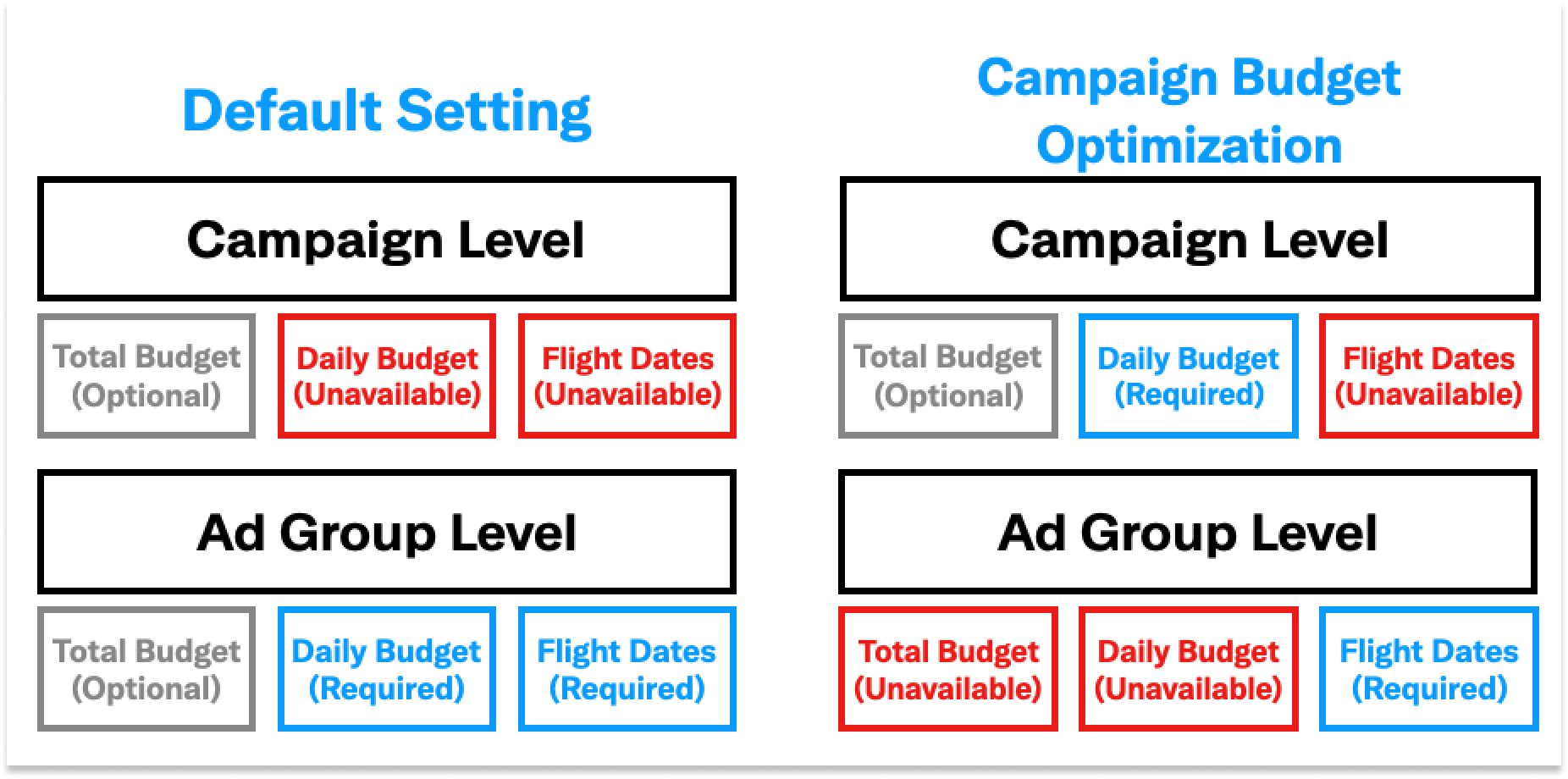
There are different budgeting options available for each level of your campaigns.
In short, the first option is ideal for ongoing campaigns, while the second is perfect for targeting specific events like limited-time offers or seasonal promotions. You can always set and update your ad group dates according to your advertising goals.
Pacing
Besides flighting, there is also pacing, or how your ad groups will be delivered based on your daily budget spending.
You can choose between two pacing options:
1. Standard delivery
Your daily budget will be spent evenly throughout the day (this is the default option). This can help you prevent early budget exhaustion and ensure that your ads run consistently.
However, since this option is based on the balance between spreading your budget throughout the day and spending it fully, you might spend more during certain hours when people are more active and likely to engage with your ads.
2. Accelerated delivery
Your daily budget will be spent as quickly as possible. This can be beneficial for time-sensitive promotions but might lead to higher costs due to increased competition during busy times and exhausting the budget too fast.
Both pacing options come with their advantages and disadvantages, but in general, it’s a good idea to stick to standard delivery when you’re running regular ongoing campaigns and accelerated delivery when you’re running time-sensitive campaigns.
Like on Facebook, Instagram, TikTok, and other popular advertising platforms, many factors can determine how much you'll pay for your ads. Knowing them all can help you manage your ad spend effectively, so always keep them in mind when planning your campaigns.
There are also several strategies that can help you optimize your advertising costs on X, so let’s go through them.
Strategies to lower X (Twitter) ads costs
1. Select the right budget and bid strategy
When you're new to advertising on X (Twitter), it can be hard to know what type of budget to choose and how high to bid for billable actions. In this situation, it's best to use automatic bidding and choose Campaign Bugdet Optimization to let X’s algorithms handle everything for you.
But as your campaign goes on, you need to keep an eye on your bids and how well your ads are doing in the X Ads Manager. This will help you figure out the right options for your situation and change your bid or budget if the ones recommended by X don't work that well.
Also, remember that lowering your bids can save you money, but you have to make sure they're still high enough to get your ads seen. On the other hand, bidding higher increases your chances of getting your ads shown, but it also costs more. You have to find the balance between the two extremes to spend your budget in the most rational and beneficial way possible.
2. Pick flighting and pacing options that suit your campaigns
Choosing how your ads run and how quickly your budget is spent is important for making the most of your money on X ads.
When you decide when your ads start and stop, think about what your campaign needs. If you're constantly advertising something, having ads that run all the time can help keep costs steady. But if you're only promoting something for a short time, like a sale or event, it's better to set specific start and end dates.
Deciding how quickly your budget is spent also matters. If you want your budget to last all day, choose the standard option. But if you're in a hurry to spend your budget to get specific results and do it fast, the accelerated option might work better.
3. Revisit your targeting strategy
To save money and get better results with your X ads, focus on reaching the right people. Instead of targeting everyone, aim for specific groups who are most likely to be interested in what you're offering. Start with a broader audience, then narrow it down as you see which groups respond best.
If you're running multiple ad campaigns, make sure they're reaching different groups of people. This prevents them from competing for the same audience's attention. Also, consider using retargeting to reach people who have already shown interest in your brand.
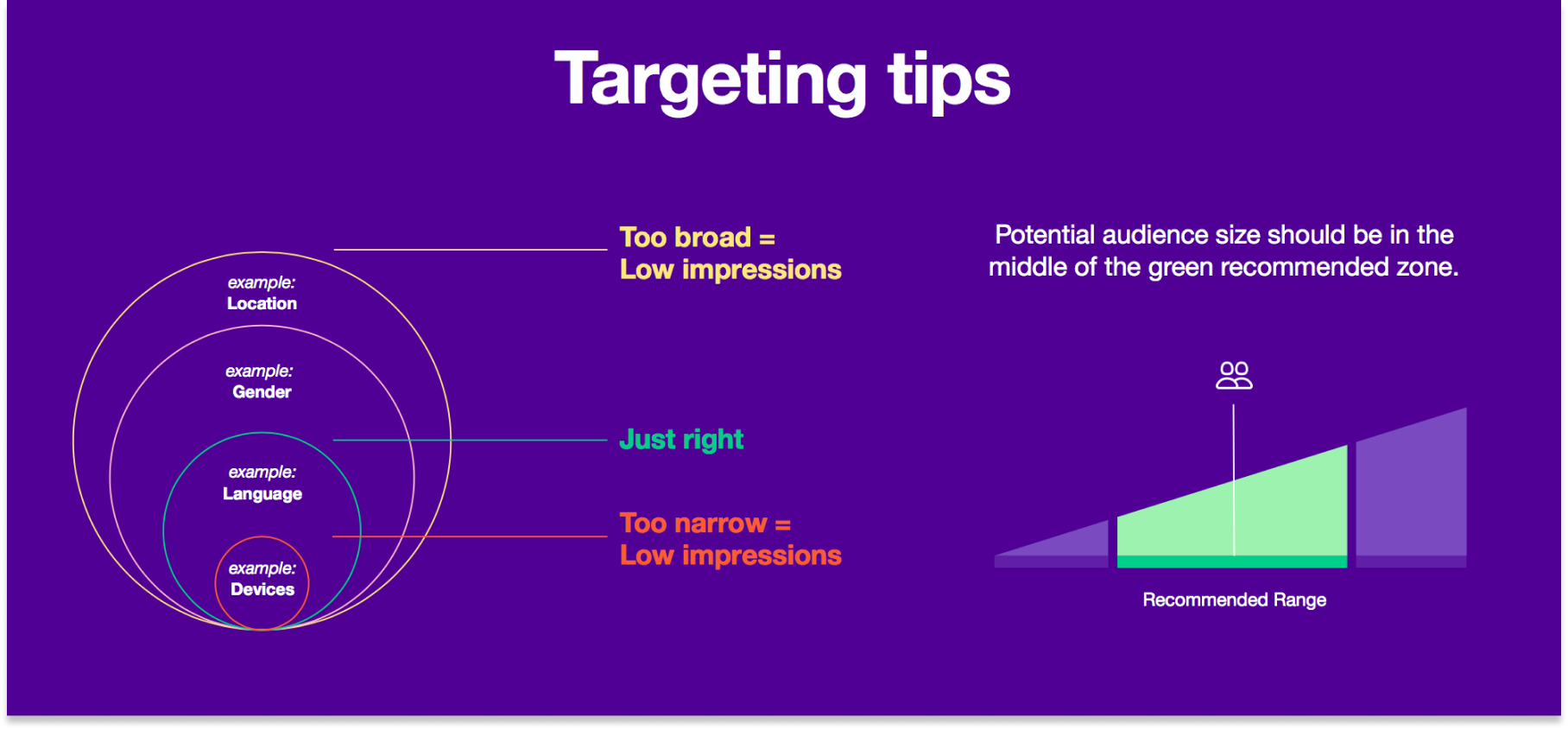
X (Twitter) recommends finding a balance between broad and narrow targeting.
It's also important to run separate campaigns for mobile and desktop users. People use Twitter differently on each device, so your ads should be tailored accordingly. Running separate campaigns helps you understand how people interact with your ads on each platform and make the most of your budget.
4. Use video formats
Video ads usually get more engagement than static images, which means they perform better and cost less per engagement. Since videos grab attention quickly, especially in the first few seconds, they can be more effective and cheaper.
If you use video ad formats, make sure your video includes clear branding in the first few seconds to improve brand recall. This means people are more likely to remember your brand, driving more organic traffic and interactions without needing to spend more on ads. Plus, video ads under 60 seconds loop, so your message gets repeated without costing extra.
Also, as X moves into the direction of being a video-first platform, it provides an opportunity to use long-form video content as well, which means you can run more than just short video ads. You can read about X ad formats, including video, in our previous article.
5. Optimize ad spending with automated rules
Automated rules can help a lot with managing your X advertising budget: they allow you to adjust ad budgets and bids based on specific performance benchmarks, pause expensive and underperforming campaigns, and a lot more.
This is useful not only for spending your money more rationally, but also for saving your time on other important tasks. And what’s even better, if you use ConvertBomb’s automated rules, you can get access to automation features not available on X itself.
Here’s just one example of how you can use ConvertBomb’s automated rules to optimize your ad spend:
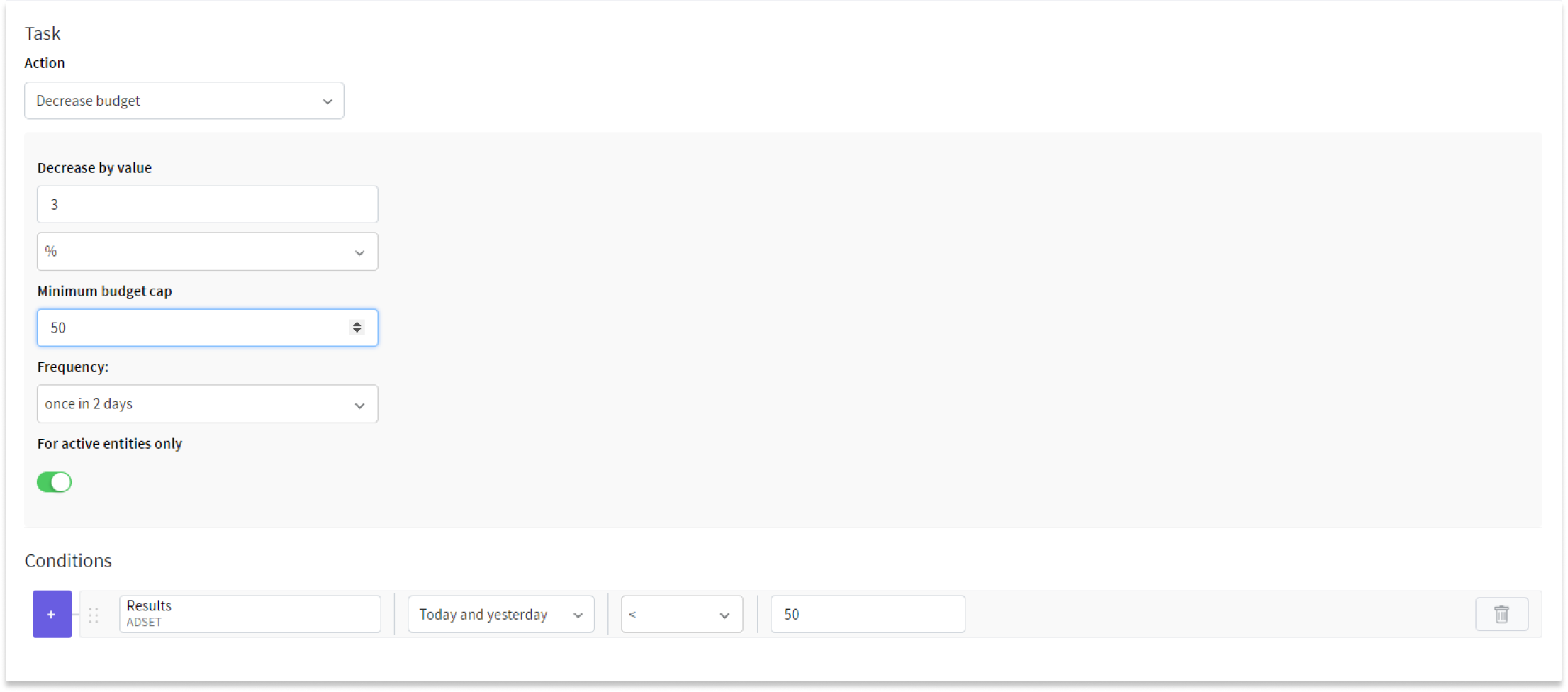
With a rule like this, you can decrease the budget for ad groups that don’t deliver enough results and allocate the money to ad groups that perform better (you can set a rule for increasing the budget to do this).
If you’re interested in how automation can help you run more successful ad campaigns on X and other platforms, check out our article about 5 automated rules for improving ad performance.
X ads’ costs: a potential benefit for advertisers?
Overall, the advertising costs on X seem relatively low in comparison with other platforms, but does that mean that X is a better place to advertise? Let’s try to answer this question.
It's been noted by many marketers and advertisers that the cost of ads on X has seen a significant decrease. According to SocialPilot, the average ROI for X ads is higher, while the costs of advertising (like CPM and Cost per engagement) are lower than on other platforms. WebFX’s data shows that most advertisers are satisfied with their X ads’ ROI, which seems like a great sign – businesses are getting good results with their X ad campaigns.
Moreover, X claims that the platform experienced a 22% increase in ad engagements in 2023, which seems pretty impressive after the news of some major advertisers leaving the platform.
Besides, the relative scarcity of competitors on X compared to Meta and other popular advertising platforms gives businesses an opportunity to gain a competitive advantage and benefit from the lack of other advertisers in their niche.
However, there are also indications that the click-through rate (CTR) has experienced a decline from the previous year, which is definitely raising concerns. There are issues with brand safety on X as well due to the risks associated with the platform's content issues.
Overall, it seems that X's ad space has become a cost-effective option for some advertisers. That being said, the platform faces a lot of challenges in attracting and retaining major advertisers, and the declining CTR doesn’t make it any better.
This doesn’t mean that you shouldn't run ads on X: instead, it shows that the platform is now in the state of undergoing changes, and it’s not clear yet how it will affect the advertising landscape. By weighing all the potential pros and cons of advertising on X right now, you can make the right choice for your business.
And if you decide to run ads on X where there are fewer competitors than on other platforms, you can potentially get a better bang for your buck.
Recap
Let’s sum up everything we’ve talked about here and answer some important questions you might have about running ads on X (Twitter).
How much do X ads cost? The costs depend on multiple factors that play a role in ad auction, but you can control how much you spend on your ad campaigns by choosing a specific type of budget and choosing how much to bid per action.
The cost per action isn’t fixed, but the right targeting choices, quality ad creatives, and campaign settings that align with your goals will help you reach a desired CPA and make sure that you’re not spending too much on your X ads.
Is X (Twitter) good for advertising? It can be, if used strategically. While the costs can vary, the opportunities to drive engagement and increase brand awareness make X ads a worthwhile investment for many businesses.
Besides, with many advertisers leaving the platform or preferring to spend their ad budgets elsewhere, you can capitalize on this and enjoy lower advertising costs than on other major platforms.
But you should also be mindful of what’s happening with the platform now and the risks it can create for your business. If you take the necessary measures to mitigate them, you can avoid the potential problems that some businesses encountered while running ad campaigns on X.
How to use X ads effectively? For this, you’ll need to know the average advertising costs and what affects them, as well as continuously optimize your campaigns to manage your ad spend better. With the right approach, X ads can be a powerful tool in your arsenal, so keep learning and optimizing.
And if you're ready to take your X advertising to a new level, sign up for a free trial to leverage the power of ConvertBomb's automated rules and optimize your ad spend.
If you want to know more about advertising costs on other platforms, check out our other guides:
- Facebook ad costs,
- Google ad costs,
- TikTok ad costs,
- LinkedIn ad costs;
- Snapchat ad costs;
- Instagram ad costs.
